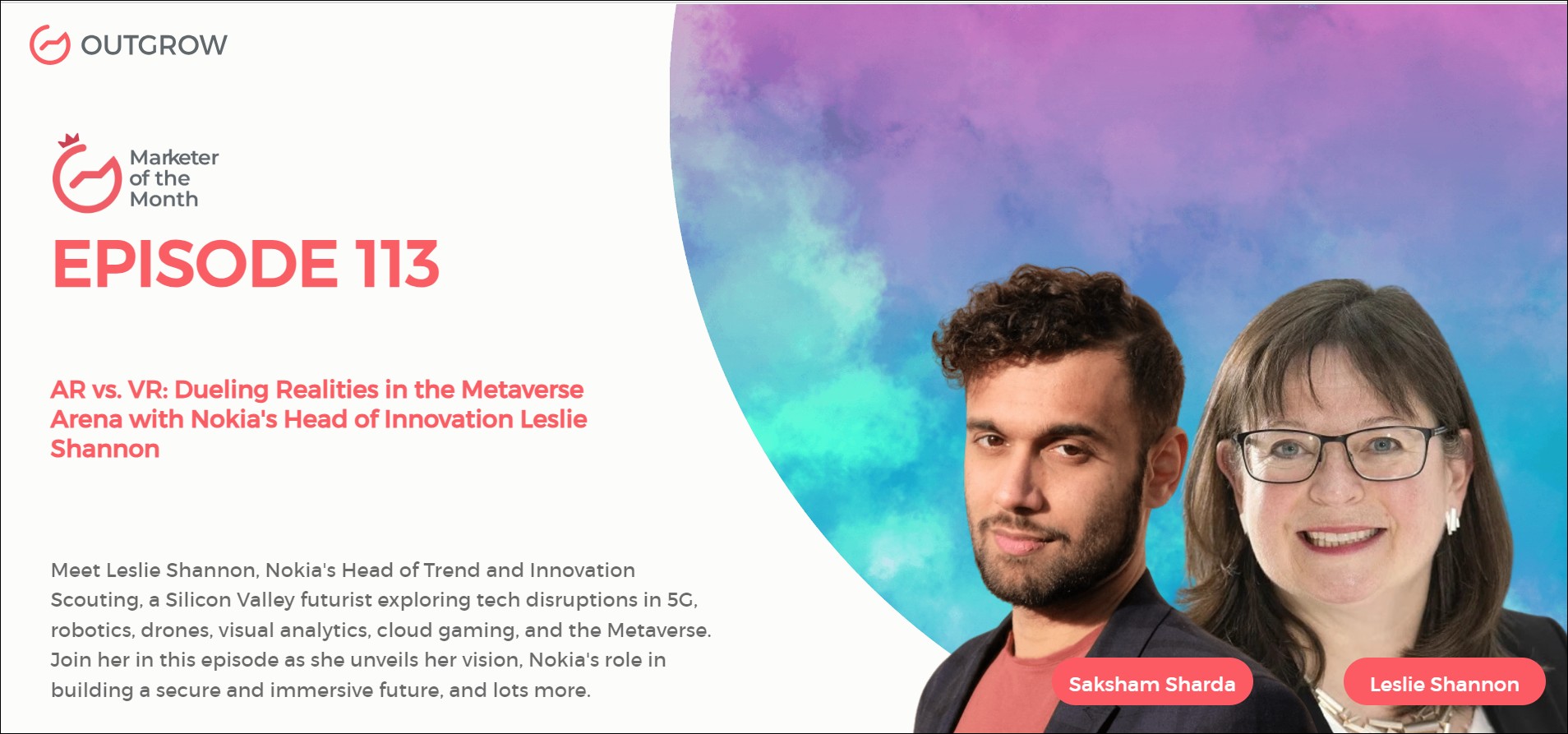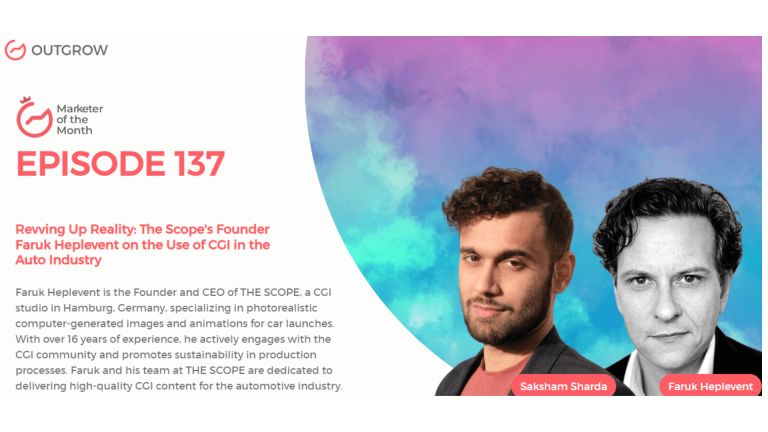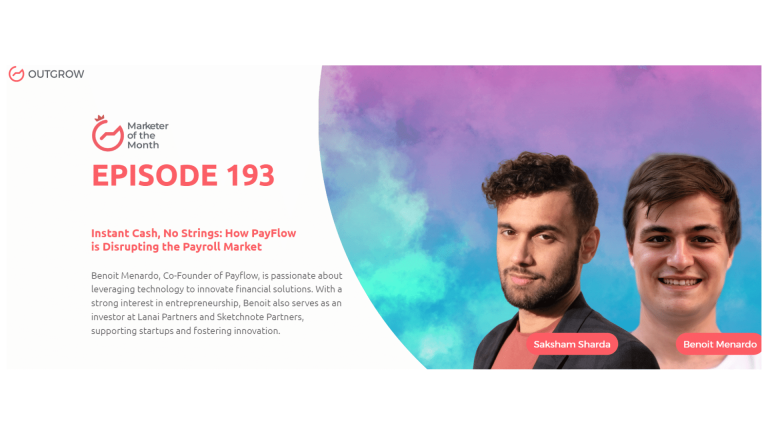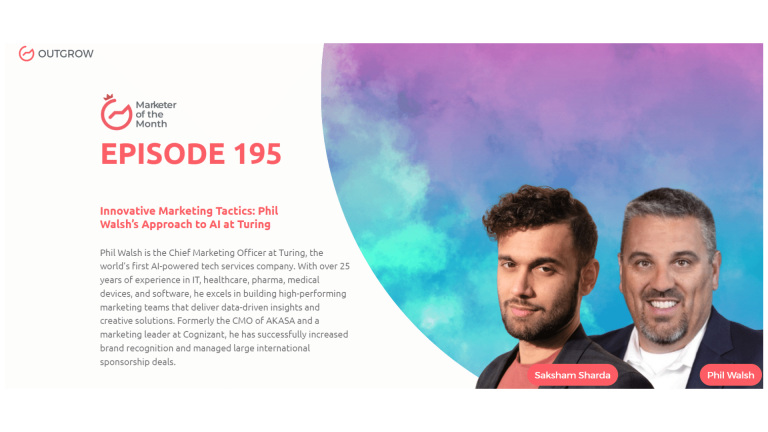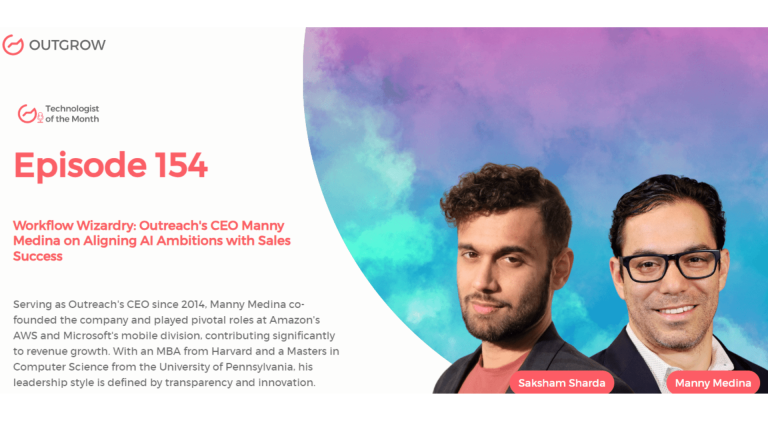EPISODE 113: Marketer of the Month Podcast with Leslie Shannon
Table of Contents
Hey there! Welcome to the Marketer Of The Month blog!
We recently interviewed Leslie Shannon for our monthly podcast – ‘Marketer of the Month’! We had some amazing insightful conversations with Leslie and here’s what we discussed about –
1. Metaverse Purpose: Bridging Digital and Physical Realities for Accessible Interactions.
2. Emphasizing Presence: Leslie Shannon’s Insights on the Crucial Metaverse Aspect.
3. AR vs. VR: Practicality and Immersion in the Metaverse Experience
4. Metaverse Continuum: Merging Digital and Physical Worlds for Hands-free Assistance
5. Privacy and Data Concerns: Ensuring Responsible Metaverse Development
6. The Future of Metaverse: Augmented Reality Glasses and AI
7. Enhancing User Experiences – Nokia’s Role in Building Secure and Efficient Infrastructure
About our host:
Dr. Saksham Sharda is the Chief Information Officer at Outgrow.co. He specializes in data collection, analysis, filtering, and transfer by means of widgets and applets. Interactive, cultural, and trending widgets designed by him have been featured on TrendHunter, Alibaba, ProductHunt, New York Marketing Association, FactoryBerlin, Digimarcon Silicon Valley, and at The European Affiliate Summit.
About our guest:
Meet Leslie Shannon, Nokia’s Head of Trend and Innovation Scouting, a Silicon Valley futurist exploring tech disruptions in 5G, robotics, drones, visual analytics, cloud gaming, and the Metaverse. Join her in this episode as she unveils her vision, Nokia’s role in building a secure and immersive future, and lots more.
AR vs. VR: Dueling Realities in the Metaverse Arena with Nokia’s Head of Innovation Leslie Shannon
The Intro!
Saksham Sharda: Hi, everyone. Welcome to another episode of Outgrow’s Marketer of the Month. I’m your host, Dr. Saksham Sharda, and I’m the creative director at Outgrow.co. And for this month we are going to interview Leslie Shannon, who is Nokia’s Head of Trend and Innovation Scouting. Thanks for joining us, Leslie.
Leslie Shannon: Great to be here. Thank you.
Don’t have time to read? No problem, just watch the Podcast!
Or you can just listen to it on Spotify!
The Rapid Fire Round!
Saksham Sharda: At what age do you want to retire?
Leslie Shannon: Yesterday
Saksham Sharda: What’s your favorite mobile app?
Leslie Shannon: Zombies run
Saksham Sharda: How long does it take you to get ready in the mornings?
Leslie Shannon: Too long.
Saksham Sharda: What’s the most embarrassing moment of your life?
Leslie Shannon: Maybe this one
Saksham Sharda: Mountains or beaches,
Leslie Shannon: Beaches.
Saksham Sharda: What’s the most useful mobile feature that you can’t live without?
Leslie Shannon: Oh wow. Half of me wants to say email and the other half wants to say games.
Saksham Sharda: How many hours of sleep can you survive on?
Leslie Shannon: Four
Saksham Sharda: Favorite color?
Leslie Shannon: Red
Saksham Sharda: What time of day Are you most inspired?
Leslie Shannon: Oh 4 pm to 2 am
Saksham Sharda: Fill in the blank, an upcoming mobile trend is_______
Leslie Shannon: The Metaverse
Saksham Sharda: The city in which the Best Kiss of your life happened?
Leslie Shannon: Wherever my husband is right now.
Saksham Sharda: Pick one Android or Apple.
Leslie Shannon: Oh, apple.
Saksham Sharda: The biggest mistake of your career?
Leslie Shannon: not leaving the company I was with before Nokia soon enough. It’s my father once said that. The biggest mistake of his career was always staying two years too long at any company that he worked with. And yeah.
Saksham Sharda: How do you relax?
Leslie Shannon: Reading
Saksham Sharda: How many cups of coffee do you drink per day?
Leslie Shannon: Zero.
Saksham Sharda: A habit of yours that you hate.
Leslie Shannon: Chewing on the inside of my mouth.
Saksham Sharda: The most valuable skill you’ve learned in life.
Leslie Shannon: Cutting yourself and everyone around you a whole lot of flack.
Saksham Sharda: Cities or countryside?
Leslie Shannon: I gotta say both on that one.
Saksham Sharda: The last one is your favorite Netflix show.
Leslie Shannon: Oh, wow. That’s all right. Sorry. I have to sit here and think which one is on Netflix.
Leslie Shannon: Yeah, exactly. Any streaming show? I don’t know. It’s on Apple. I’m a huge Ted Law. So fan.
Saksham Sharda: All right. And so, the rapid-fire is over.
The Big Questions!
Saksham: So let’s go into the bigger questions which you can answer with as much ease and time as you’d like. Okay. What, in your opinion, is the purpose of the metaverse, and what change will the evolution of the metaverse bring about?
Leslie Shannon: Yeah, so I’m going to do a shameless plug for my book right here. And so I just finished writing a book called interconnected realities. It’s coming out in June. It’s available for pre-order on Amazon right now. And, and the thing is that I asked myself the question, what is the purpose of the metaverse, and then I looked at each of the different iterations of the metaverse that are out there right now. And I asked that question of each one. And what I found as a result of going through that exercise is that a lot of times we equate, or, you know, people are equating the metaverse with full immersion, or with web three or something like that. What I found is that the common theme where we actually see the metaverse Solving problems is the concept of presence. The concept of using digital means to connect you in your physical reality with people or information or locations that are not physically present with you. And that actually solves problems that bring me the information I didn’t know that makes the invisible visible. That actually brings me together with people that I’m not with right now. And so because if you talk about immersion as much as I love immersion, much as I love Virtual Reality full-on digital worlds because I do all of my I do all my physical exercise, my fitness, my daily fitness in virtual reality, and I have for the last four years. And I love VR. But the honest truth is that when you put on a VR headset, you are cutting yourself off from the physical world, and that’s fine for a limited amount of time. But it’s like going to a movie theater. You’re not going to be doing it all day, every day. Because and especially talking to the women out there, we know what it is to have people depend on us. At some point, you have to take your headset off and talk to your kids and go make dinner for everyone. So I found that people who were saying, you know, oh, we’re gonna be in the metaverse all the time and do all of our shopping or socializing in there. It’s like the people who are saying that probably are not the ones who have to go make dinner, you know, just saying. So immersion is great, but it is not equivalent to the metaverse. I actually find, as I said, presence is the thing uniting us with the people and information that’s not immediately visible in our physical surroundings. And that’s what the metaverse is all about.
Saksham Sharda: So the metaverse has been described as a digital utopia. But is it possible to create a perfect society online when real-world issues like inequality and discrimination still exist and might continue to exist in the metaverse?
Leslie Shannon: Yeah, actually that that question presupposes that the metaverse is kind of this world that we enter into. And I really, you know, and while there is an aspect of that with the metaverse for me, the metaverse is it’s the union of the digital and the physical. The physical is still extremely, extremely important. So you know, so we have this continuum, right? There’s the full digital here and the full physical here. And the metaverse is really everything on the spectrum where digital and physical are being added together. And as I said, I think the fully digital Metaverse is something it’s limited utility. It’s a limited purpose. It’s, it’s not that it has no purpose. It does have a purpose. But it’s not all the time. So where most of the metaverse activity is going to happen is in this bit in the middle, where we stay in our physical world and have digital elements that are added to that. And, in a way, you know, one of the serious problems that solves that we have right now is the problem of the screen. Because right? You know, it sounds a little funny coming from somebody from Nokia. But the idea of a screen that we’re staring at that is something that’s a problem we have today. That’s actually very dystopian, and it’s taking us away from the world, and the people around us because we our gaze is dead ending in the screen. And so what the metaverse is ultimately going to do by moving into glasses that let us mostly see the physical world, but with digital elements added into it. That puts us back in the world, it means that our gaze and in the physical world again. So in a way, I actually think that the metaverse is the solution to the dystopia that we have now, of everybody sitting around a table in a restaurant and everybody’s staring at a screen instead of looking at each other. That’s hell on earth. And we have that now, we don’t talk about that enough.
Saksham Sharda: But even a 3D gaze is removing us from the world in some way or how would you kind of perceive that?
Leslie Shannon: you know, I think, excuse me, so here’s, you know, here’s a scenario, I’m wearing, you know, head-mounted devices, you know, some kind of AR glasses, and I’m walking along, and I’m walking my dog. And, and, and I see a flower, and I want to know what kind of flower it is, and taking out my smartphone and using, you know, some kind of camera-based thing in my smartphone to figure out what the flower is or what bird song I’m hearing right now, that’s a little awkward, because I’ve got a hand on my dog leash, making this kind of information that you can that we can get from our smartphones today. Actually, then, making it so that we get that information hands-free. That’s actually really key. And that’s the change. Again, we’re back to you know what problem does the metaverse solve the idea of having? I mean, I should be clear by now. For me, the really powerful Metaverse is augmented reality. Metaverse, not the virtual reality metaverse. And so you know, so I can still be walking my dog get the information that I want, you know, on-demand for I’m in control, and I’m not being served a ton of ads all the time. You know Yeah. That’s actually my vision of what the metaverse is and what’s going to be interesting and solve problems for people.
Saksham Sharda: So how would you balance your excitement for new developments and this with a sense of caution and responsibility?
Leslie Shannon: You know, I think it’s actually great that in the web two eras, some very notable companies got into really big problems with privacy violations. Because that puts everybody on notice that if you violate people’s privacy, you know, your company is going to be rejected by the people of the world. And so that is a lesson that, thankfully, we see almost all the big players bringing into the creation of the metaverse. Does that mean we’re not going to see privacy violations? Unfortunately, no, you know, mistakes will be made. Each time we have a new technology, a significant new technology, we don’t know as a society where the edge of the cliff is until somebody goes over it. But then once somebody goes over the edge of the cliff, we all go, Oh, that was the edge of the cliff, we’re gonna put a fence up there. Now. We’re gonna have a lot of that going forward. But it’s, it’s, it’s the same with every new technology that comes up, you know, same old story.
Saksham Sharda: So what are some of the possible edges of cliffs that we are seeing right now?
Leslie Shannon: It’s, um, I think one of the double-edged swords that we’re seeing right now is the idea of headsets. And here, I will talk about virtual reality headsets that actually have cameras pointed at you that are doing things like analyzing your gaze or analyzing your emotions, that can be amazing for all kinds of training, for example, to really understand, you know, you and your emotional reaction to things. You know, like in public speaking training, for example, where did your eyes fall? Were you looking at people in the eyes, in your virtual reality world where they’re training you to be a public speaker? But at the same time, there’s room in the marketplace for headsets that don’t do any of that tracking for people who do not want that tracked ever, ever, ever. And so they don’t even want the hardware. And we see this playing out in the headsets that are on offer right now. Some have the tracking available. Some do not. And, yeah, we’ll have to see because there’s utility there. But there’s also the potential to over-measure, and potentially abuse the stuff that’s collected. And so far, so far, we haven’t seen any abuse cases, which is really good. But, you know, anytime you gather data and you store data about people, problems can arise. So fingers crossed, here’s hoping we don’t see too many.
Saksham Sharda: So in your experience, what are some common technological challenges that arise when multiple partners come together to create a new platform or technology? And How can these challenges be overcome?
Leslie Shannon: I was I’ve been with Nokia for 23 years now. And of the beginning of my career. So way back in the early days, the earliest days of mobile data, I managed a lab in Australia called The Future Lab. And we were trying to figure out what we were building applications for first Whap and then GPRS, and then and then 3g. And the thing that I found that was when we were working with partners, which we did, we worked with external developers. There was never a technical problem that couldn’t be solved, you know, either with DirectX, you know, like, hey, we’d come up with something new, or with some kind of workaround, but still, technical problems were never the problem. The tricky thing with partnerships is the business side of things. Anytime we had a project that did not achieve its stated goals. When partners were involved, it was because somebody had freaked out at some area of the business or some area of legal that. So in my experience, that’s actually the harder aspect of business partnerships is getting a business case that is fair and win-win for everybody involved. Nobody’s being victimized. You know, we’re exploited. And the other side is, you know, just making sure that the legal grounds are okay. Technically, yeah, I’ve never seen anything fail on technical grounds, frankly.
Saksham Sharda: So, how do you envision the metaverse evolving over the next 5 or 10 years? And what impact do you think it would have on society and technology?
Leslie Shannon: The metaverse is going to evolve from the kind of three-dimensional digital world where you’re an avatar, and I’m an avatar, which is kind of the pick-the-mental picture that a lot of people have now. And there’s certainly plenty of spaces where you can do that right now into much more of a digital, physical fusion, where I’m wearing a headset, most of what I see is the physical world around me, but there are digital elements added into it that give me information that I didn’t know before. Like, for example, you know, Here we are at Mobile World Congress. And I’m talking to all these people all the time, and they’re coming up with me, and I’ve never met them before. And it’s a whirlwind. And I may not remember at the end of the day who I’m talking to if I have glasses, that actually can you, and it’s also like when somebody’s wearing a nametag. It’s rude when you like, kind of like, look at the nametag if I have glasses, and instead, they’re scanning. They spot the name tag. And then they’re recording, for example, who I spoke to. And then at the end of the day, I get this list. These were the people that you spoke to for more than 30 seconds or whatever criteria you want to make. And then these other names and these are their contact information. Then I can go back and, you know, that kind of thing. That’s the metaverse. That’s where and noticed there’s a lot of AI in that too. And so this combination of being able to, well, the digital and the physical still being very much in the physical world, but with digital assistance in all kinds of ways around you all the time. Like magic, you know, anything that you can think of where you’d like to make the invisible visible. That’s the metaverse
Saksham Sharda: I guess it’s kind of also a co-pilot, but that is helping you.
Leslie Shannon: Yeah, absolutely. Absolutely. And excuse me, so yeah, 100% copilot but never a slave driver. And that’s a really important distinction.
Saksham Sharda: So the rise of concerns over privacy and data security. Do you think that the development of the metaverse and the increasing use of AR and VR will only exacerbate these issues? How does Nokia plan to address these concerns?
Leslie Shannon: Yeah, well, within for Nokia plays in the metaverse is today. What we see we see three main areas within the metaverse that are our focus the industrial Metaverse, the enterprise Metaverse, and the consumer metaverse. Now the consumer Metaverse where we’ll be involved as that comes a little bit later. So right now, we’re kind of the industrial in the enterprise Metaverse, which is very much, you know, digital twins and training and education, and all of these kinds of things. And so security and privacy are not so many elements in those. So, overall, actually, wait, let me put that another way. Your, personal data that’s, that’s not so much an element and those meta verses, but keeping your corporate information safe. Yes. 100%. And that’s why, I mean, if you look at a lot of most of the things that are happening in the metaverse right now when you look at it from a connectivity point of view, they’re happening over Wi-Fi. But when you are dealing with the industrial Metaverse or the enterprise Metaverse, and you want to make absolutely sure there’s nobody with a Wi-Fi sniffer sitting in your parking lot hoovering up your corporate data, that’s when you might actually want to be using, say, a private 5g network, which is where we come in, to have that connection to give you that kind of AR or VR experience within your corporate area. And you know, it’s 100% rock solid, safe, and secure.
Saksham Sharda: Alright, So what product is Nokia displaying today at the MWC?
Leslie Shannon: Actually, I am not the person to ask about that, honestly.
Saksham Sharda: Okay, so besides MWC what other shows do you attend or have attended or plan to attend?
Leslie Shannon: Let’s see. I will be at South by Southwest in Austin in a couple of weeks. And CES. At the Consumer Electronics Show, where I was actually CES this year, I was delighted to see augmented reality glasses and virtual reality headsets from a huge number of players that I had never imagined. We’re getting into this business, the hardware part of this. So when we’re talking about the metaverse, actually, where we are with the metaverse is about the same as the internet in 1993. Super, super early, we are still in the infrastructure phase, we are still at the point where we’re trying to lay everything down from the headset all the way through to the data centers with the connectivity and the processing. We got to get all that in place. And you know, and so the headsets are still a little big and a little heavy and everything. And so as we actually develop it, once it’s fully in place in a way that it can work. That’s when the creatives come in, and that’s when they start showing us what this thing is really going to be because until then. We don’t really know. In the same way, we didn’t really understand what the internet was going to do for us until we actually had not just the internet but the mobile internet and location-based information. And that was when you started getting things like Uber and Airbnb. It’s like, oh, this is what, But the internet is for the same thing. We’ve got to, we’ve got to kind of just believe in the concept, even if we’re not really sure what it is, build the infrastructure. And then we will figure out what this Metaverse thing is for.
Saksham Sharda: How does it like all these companies that are burgeoning with VR headsets? Do you think how do they address the key concern of motion sickness that people feel after a while? And is that a concern that can be addressed? Because I feel, to an extent, VR will not progress to where it can if motion sickness exists.
Leslie Shannon: Yeah, there are a couple of different causes for motion sickness within virtual reality. And some of it can be solved by the way that developers go. Like, for example, if I’m in a VR game or a VR environment, there are two different ways to locomote. One is to, you know, to point and then teleport to the location that you pointed to. The other is to glide. Gliding makes me instantly motion sick, no matter what the application. And so, So developers stopped gliding. Just don’t even don’t do that. There’s, I mean, there are games that I would, I’m not gonna name any names here. But there are games that I would love to play, but I can’t because they don’t have the teleport. They only have a glide. Yeah. So no, yeah. So that’s on the developer side. However, another part of it is actually the network. Because motion is one of the causes of motion sickness, not the only one, but one of them is if there is a lag time between what you are feeling or what your inner ear is feeling and then what your eyes see. It’s about a 710-millisecond gap or lag time within your brain, you know, so you know, you move your head, and you move your eyes. And then your brain knows about it. If you’re wearing a VR headset, and you turn, and the visuals turn, like 30 milliseconds later, you as a person, we don’t, we can’t detect that that’s such a low tide, but our brain gets it. And that causes motion sickness. And so really good connectivity. So right now, you know, most well, all VR headsets run on Wi-Fi. So you need to have your Wi-Fi connected to a network that is fast. So if you’re having problems at home with, you know, with VR motion sickness, check your network, you might need to get fiber, or you might need to upgrade your Wi-Fi router because poor connectivity can cause that delay, which can cause motion sickness. So, so what I’m saying so my answer is, really, it’s something that there are technical causes for motion sickness that we, as an industry, can address. And we definitely, you know, at Nokia, for sure, we’re working on the connectivity side of that. Absolutely.
Saksham Sharda: The last question, as opposed to, what would you be doing in your life if not this right now?
Leslie Shannon: You know, I am my role is Nokia’s head of trend scouting. I go around looking at technology trends, participating in them talking to the people involved. I am living my best life, you know, it just doesn’t get any better than this.
Let’s Conclude!
Saksham Sharda: Thanks, everyone for joining us for this month’s episode of Outgrow’s Marketer of the Month. That was Leslie Shannon, who is Nokia’s Head of Trend and Innovation Scouting. Thanks for joining us, Leslie.
Leslie Shannon: Pleasure. Thanks for having me.
Saksham Sharda: Check out the website for more details and we’ll see you once again next month with another marketer of the month.

